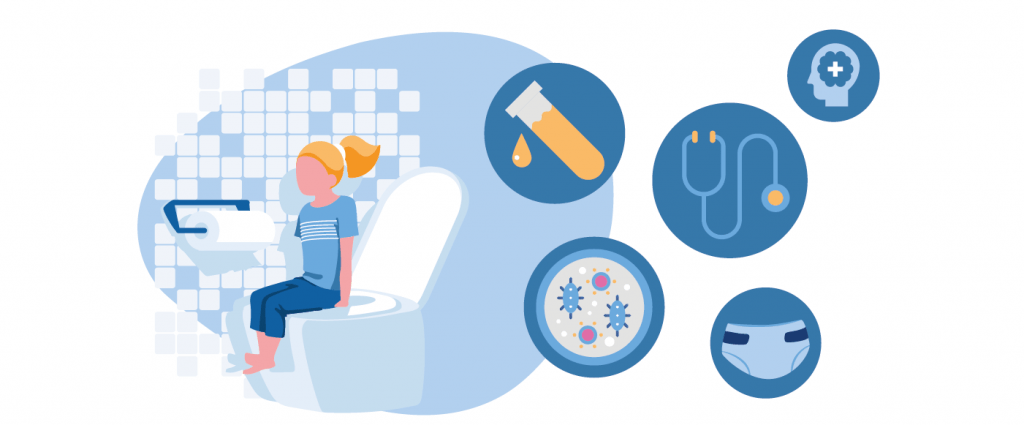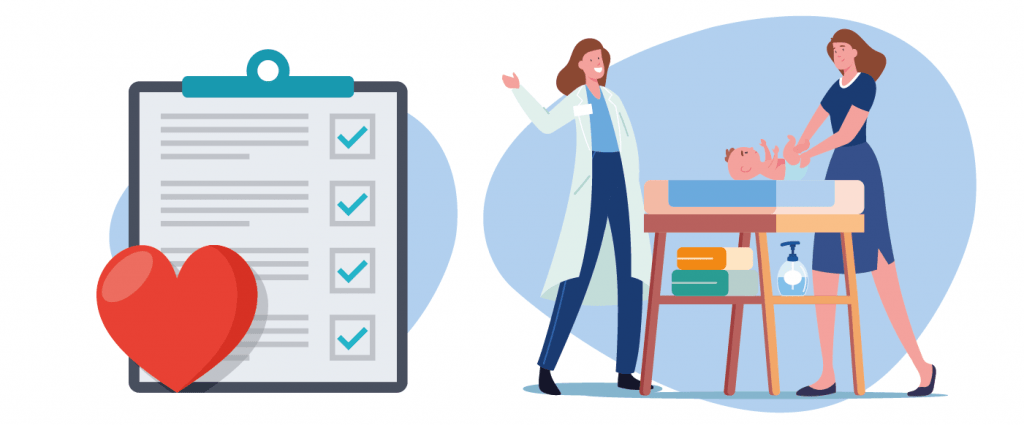What causes UTIs in infants?
Urinary tract infections (or UTIs) are among the most common infections in young children1; in fact, UTIs cause 7% of fevers in infants2. However, it can be difficultto tell if your little one has a urinary tract infection, as symptoms can be vague, and babies and toddlers may not be able to communicate how they’re feeling.3 To help you out, we’ve gathered all the facts on symptoms of UTIs in infants, the possible causes and how to manage them.

UTI symptoms in infants
Urinary tract infections in infants can be tricky to recognise in infants. As a parent, some signs to watch out for in your little children are:
- an unexplained fever
- irritability and crying more than usual
- feeding less
- vomiting
- being unusually sleepy
- poor weight gain
- blood in their nappy.4
However, it’s worth bearing in mind that a raised temperature or seeming unwell are often the only symptoms of UTIs in infants.5
While these symptoms are not limited to urinary tract infections, it’s always recommended that you speak to a healthcare professional if you suspect your little one has a UTI, especially if they have a high fever or are confused or drowsy.6

How are UTIs in infants diagnosed?
If a doctor thinks your child has a urinary tract infection, they’ll likely ask for a urine sample.7 Obviously, this can be tricky for infants who aren’t toilet trained, as they can’t ‘wee on demand’. Therefore, the healthcare provider may suggest you collect a sample by rubbing their tummy with wet gauze to encourage urination and then catching the wee in a sterilised potty or on a urine collection pad.8 If this isn’t possible, the doctor may need to insert a catheter.9 They’ll then perform a urinalysis (testing the wee) to determine if your baby has a UTI.10
Causes of UTIs in infants
Most UTIs in infants are caused by bacteria from the digestive system entering the urinary tract through the urethra.11 Girls are more likely than boys to get UTIs as the anus is closer to the urethra.12 Bacteria can also be introduced to the urethra due to:
- poor hygiene
- difficulty completely emptying the bladder or ‘holding on’ to wee
- having recently had a catheter inserted13
- constipation
- strong hygiene products that can irritate the area.14

Manage and preventative measures for UTIs in infants
UTIs in infants are usually easy to treat, though they can lead to complications if left untreated15; therefore, it’s important to speak to a doctor if you believe your child has a urinary tract infection. Infants are normally prescribed antibiotics when they have a UTI, and they need to take the full dose to ensure the infection is eliminated.16
Treating UTIs in babies and young children
In addition to following your healthcare practitioner’s recommendations, there are several home remedies that can ease symptoms of UTIs in infants, such as:
- ensuring your child drinks plenty of fluids
- keeping taking their temperature if they seem to have a fever (and speak to your doctor if their temperature goes above 38.3°C)17
- choosing breathable and anatomically-shaped nappies or pants to keep your little one comfortable and dry. iD’s nappies and pants range for babies and toddlers quickly absorb fluid, allowing your child to get on with their daily life
- giving them (liquid) paracetamol or ibuprofen to reduce pain and/or fever.18
Recurrent UTIs in infants and children (three urinary tract infections within a 12-month period19) require different management and may warrant further investigation.20 iD recommends speaking to your GP if your child experiences frequent UTIs.
Preventing UTIs in infants and toddlers
If you’re concerned about your baby developing a UTI, don’t worry; you can do a few things to decrease the likelihood of this. Steps you could take to prevent UTIs in babies include:
- if you can, exclusively breastfeed your baby for the first six months, as this boosts your little one’s immunity and helps prevent constipation
- avoid using scented soaps and bubble bath
- speak to your GP if persistent constipation is an issue for your child21
- change their nappies regularly to prevent the spread of bacteria22 and clean the area well with gentle cleansers or wipes23, such as iD’s Sensitive Cleansing Wipes.
In toddlers and little children, follow the guidance below to prevent urinary tract infections:
- instruct your child to wipe from front to back after using the toilet, as this helps prevent bacteria from being transferred from the anus to the urethra
- ensure they’re hydrated and urinate frequently
- give your little one loose cotton underwear because this doesn’t promote the growth of bacteria.24
If you’d like more information on bladder issues and children, check out the iD Junior Blog, where you can find articles on a range of bladder-related topics written with parents in mind.
Sources
1 “Pediatric Urinary Tract Infection”, Donna J Fisher, MD, 19 March 2019, Source: https://emedicine.medscape.com/article/969643-overview
2 “Urinary tract infections in children: an overview of diagnosis and management”, Jonathan Kaufman, Meredith Temple-Smith & Lena Sanci, 2019, Source: https://bmjpaedsopen.bmj.com/content/3/1/e000487
3 “Urinary tract infection (UTI) in children”, NHS 24, 14 February 2020, Source: https://www.nhsinform.scot/illnesses-and-conditions/kidneys-bladder-and-prostate/urinary-tract-infection-uti-in-children
4 “Urinary tract infection (UTI) in babies”, raisingchildren.net.au, 22 December 2021, Source: https://raisingchildren.net.au/guides/a-z-health-reference/urinary-tract-infection-in-babies-and-toddlers
5 “Urinary Tract Infections In Babies”, Christina Ching, MD, 6 January 2021, Source: https://www.nationwidechildrens.org/family-resources-education/700childrens/2013/11/urinary-tract-infections-in-babies
6 “Urinary tract infections (UTIs)”, NHS, 18 November 2020, Source: https://www.nhs.uk/conditions/urinary-tract-infections-utis/
7 “Urinary tract infections in infants and children: Diagnosis and management”, Joan L Robinson, Jane C Finlay, Mia Eileen Lang, Robert Bortolussi, and Canadian Paediatric Society, June-July 2014, Source: https://www.ncbi.nlm.nih.gov/pmc/articles/PMC4173959/
8 “How should I diagnose a urinary tract infection?”, National Institute for Health and Care Excellence, February 2019, Source: https://cks.nice.org.uk/topics/urinary-tract-infection-children/diagnosis/diagnosing-a-urinary-tract-infection/
9 “Urine samples”, The Royal Children’s Hospital Melbourne, March 2018, Source: https://www.rch.org.au/kidsinfo/fact_sheets/Urine_samples/
10 “Urinary tract infections in infants and children: Diagnosis and management”, Joan L Robinson, Jane C Finlay, Mia Eileen Lang, Robert Bortolussi, and Canadian Paediatric Society, June-July 2014, Source: https://www.ncbi.nlm.nih.gov/pmc/articles/PMC4173959/
11 “Urinary tract infection (UTI) in children”, NHS 24, 14 February 2020, Source: https://www.nhsinform.scot/illnesses-and-conditions/kidneys-bladder-and-prostate/urinary-tract-infection-uti-in-children
12 “If Your Child Gets a UTI”, Amita Shroff, MD, 6 March 2021, Source: https://www.webmd.com/children/if-your-child-gets-a-uti
13 “UTI Symptoms, causes, treatments, remedies, and all else you need to know”, James McIntosh, 9 December 2021, Source: https://www.medicalnewstoday.com/articles/189953
14 “Urinary tract infections”, Canadian Paediatric Society, January 2020, Source: https://caringforkids.cps.ca/handouts/health-conditions-and-treatments/urinary_tract_infections
15 “Urinary Tract Infections (UTIs)”, Nicole Inman, CNP, July 2021, Source: https://www.cincinnatichildrens.org/health/u/uti
16 “Urinary tract infections (UTIs)”, NHS, 18 November 2020, Source: https://www.nhs.uk/conditions/urinary-tract-infections-utis/
17 “Urinary Tract Infection in Children”, Anna Giorgi, 7 December 2018, Source: https://www.healthline.com/health/urinary-tract-infection-children
18 “Urinary tract infections in babies”, SickKids staff, 18 October 2009, Source: https://www.aboutkidshealth.ca/article?contentid=510&language=english
19 “Recurrent Urinary Tract Infections Management in Women”, Ahmed Al-Badr & Ghadeer Al-Shaikh, 25 June 2013, Source: https://www.ncbi.nlm.nih.gov/pmc/articles/PMC3749018
20 “Recurrent Urinary Tract Infections (UTIs) in Children, American Academy of Pediatrics, Source: https://www.healthychildren.org/English/health-issues/conditions/genitourinary-tract/Pages/Urinary-Tract-Infections-in-Teens.aspx
21 “Urinary tract infection (UTI) in children”, NHS 24, 14 February 2020, Source: https://www.nhsinform.scot/illnesses-and-conditions/kidneys-bladder-and-prostate/urinary-tract-infection-uti-in-children
22 “Urinary Tract Infections (UTIs)”, T. Ernesto Figueroa, MD, October 2021, Source: https://kidshealth.org/en/parents/urinary.html
23 “Treatment for Bladder Infection in Children”, NIDDK, April 2017, Source: https://www.niddk.nih.gov/health-information/urologic-diseases/urinary-tract-infections-in-children/treatment
24 “Urinary tract infection (UTI) in children”, NHS 24, 14 February 2020, Source: https://www.nhsinform.scot/illnesses-and-conditions/kidneys-bladder-and-prostate/urinary-tract-infection-uti-in-children
